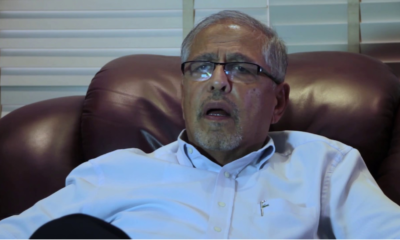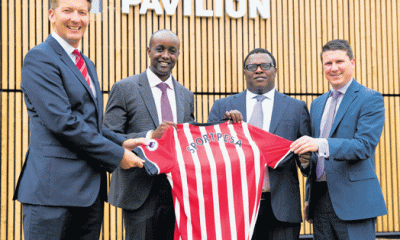Coronavirus
We Don’t Know Why COVID-19 Cases, Deaths Are Not High In Africa — Bill Gates
Co-founder of Microsoft Foundation, Bill Gates, has said he does not know why COVID-19 cases and deaths in Africa are low as against the figures obtainable in developed countries.
According to Gates, it is possible that the figures provided are not real due to the gaps in health care systems in Africa.
 Bill Gates Harry Graphic
Bill Gates Harry Graphic
He said, “It is also possible—though I hope this is not the case—that the true numbers are higher than they look because gaps in poor countries’ health care systems are making it hard to monitor the disease accurately.”
In a report on his website, GatesNotes titled, ‘These breakthroughs will make 2021 better than 2020’, the billionaire explained that the early lockdown imposed by some African countries could be responsible for the low rate of COVID-19 cases.
He added, ‘In Africa, another reason may be that the population is young compared with the rest of the world’s, and young people are less susceptible to the virus. Another reason could be that its large rural population spends a lot of time outside, where it’s harder to spread the virus.”
Read The Article Below:
These breakthroughs will make 2021 better than 2020
“This has been a devastating year. More than 1.6 million people have died in the COVID-19 pandemic, with more than 75 million cases and tens of trillions of dollars in economic damages. Millions of people are out of work and struggling to pay their bills, and more than a billion children are missing out on crucial time in school. In the U.S., this year also saw the horrifying killings of George Floyd and Breonna Taylor, ruinous wildfires, and a presidential election unlike any other in modern times.
But there is good news coming in 2021.
I spent most of my time this year working with colleagues at the foundation and around the world on ways to test for, treat, and prevent COVID-19. When I think back on the pace of scientific advances in 2020, I am stunned. Humans have never made more progress on any disease in a year than the world did on COVID-19 this year. Under normal circumstances, creating a vaccine can take 10 years. This time, multiple vaccines were created in less than one year.
Unfortunately, we are not out of the woods quite yet. Computer models suggest that the pandemic could get even worse over the next month or so. We also need to learn more about a new variant of the virus that has appeared, which seems to spread faster but not to be more deadly.
Still there are two main reasons to be hopeful. One is that masks, social distancing, and other interventions can slow the spread of the virus and save lives while vaccines are being rolled out.
The other reason to be hopeful is that in the spring of 2021, the vaccines and treatments you’ve been reading about in the news will start reaching the scale where they’ll have a global impact. Although there will still need to be some restrictions (on big public gatherings, for example), the number of cases and deaths will start to go down a lot—at least in wealthy countries—and life will be much closer to normal than it is now.
In this post, I want to share where things stand on COVID-19 innovations as we wrap up this year and move into the next. I’ll start with vaccines, since they’ve been in the news so much and that’s the area I get asked about the most.
How COVID-19 vaccines work
You probably know that two vaccines—one developed by Moderna, the other by Pfizer and BioNTech—have received emergency approval in the U.S. The Pfizer/BioNTech vaccine has also been approved in the U.K. and other countries. And several other companies will probably be announcing results of clinical efficacy trials soon.
What you might not have read is that the success of the first two vaccines also bodes well for many of the other candidates. Virtually all of the vaccines now undergoing efficacy studies attack the same part of the novel coronavirus as the first two do. (It’s the protein that spikes out of the virus, giving the coronavirus its crown-like shape as well as its name.) Now that researchers know attacking that particular protein can work, they have reason to be optimistic about other vaccines that do the same thing.
Despite this basic similarity, the various vaccines use different approaches to attacking the virus. The ones developed by Moderna and Pfizer/BioNTech involve what’s called mRNA technology—an approach our foundation is intimately familiar with, because we’ve been funding research on it since 2014 as a way to create vaccines for malaria and HIV. It’s great that the technology is now allowing unprecedented progress on COVID-19.
It’s no accident that mRNA vaccines were the first out of the gate. By design, this type of vaccine can be created faster than conventional ones. It works by using messenger RNA to deliver instructions that cue your body to produce the distinctive spike protein. Then your immune system kicks in and attacks anything with that spike on it, including the COVID-19 virus.
Making mRNA vaccines is relatively fast because it’s much easier to produce large quantities of an RNA sequence that codes for the spike protein than it is to grow the spike protein itself. And there’s a bonus benefit: Unlike most conventional vaccines, mRNA vaccines don’t contain any virus at all, which means you can’t get COVID-19 from them.
Unfortunately, there aren’t yet many factories where mRNA products can be made. Some also need to be stored at temperatures as low as –70°C, which makes them particularly difficult to distribute in developing countries, though this is more of an engineering challenge than a scientific barrier.
An example of a different type of vaccine is the one made by AstraZeneca. Instead of using mRNA, it attaches the spike protein to an otherwise benign virus that causes the common cold in chimpanzees but is harmless for humans. Then your immune system learns to attack that spike, and you’re protected from COVID-19.
In its clinical efficacy trials, the AstraZeneca vaccine was on average around 70 percent effective, versus 94 to 95 percent for the Pfizer and Moderna vaccines. But 70 percent is still high enough to be effective at stopping the disease. And it’s reason to be hopeful about other vaccines that take a similar approach, such as Johnson & Johnson’s.
I don’t blame you if you have a hard time keeping track of all the companies working on vaccines. But it’s a nice problem to have! With so many companies pursuing different approaches, there was a much better chance that some would prove to be safe and effective. There are two already and more may be coming.
It’s unheard of to have so many companies working on vaccines for the same disease, because making a vaccine is inherently risky work. Not only can it take years to get a product to market, but it can cost billions of dollars and involve major scientific challenges—especially when the disease is as new to us as this one is.
Why were so many companies willing to take the risk this time?
Judging from the conversations I’ve had with their leading scientists and executives, I think one reason is that they saw a chance to use their expertise to help end the pandemic. It also helped that others stepped up to bear some of the financial risk. In some cases, it was a national government, such as the U.S. or Germany. In others it was the group called CEPI, the Coalition for Epidemic Preparedness Innovation, which is funded by our foundation and several government and philanthropic partners.
Of course, developing the vaccines themselves is only part of the challenge. And it may not even be the hardest part.
How do you make 5 to 10 billion doses?
The world will have to manufacture around 5 billion doses if there’s a vaccine that requires only one dose, or 10 billion in the current scenario of two-dose vaccines. (This is assuming that 70 percent of the global population must be covered in order to break transmission of the disease.)
Is 5 to 10 billion doses a lot? Well, all the vaccine companies in the world typically produce a total of fewer than 6 billion doses a year. That includes flu shots, routine childhood immunizations, and so on. So to produce all the COVID-19 vaccines needed without cutting back on any others, the manufacturing capacity will at least need to almost double, and more likely almost triple.
To help ease the manufacturing burden, our foundation helped put together what’s called “second-source agreements.” We paired vaccine companies in rich countries with counterparts in developing countries that specialize in producing safe, high-quality, and affordable doses at a very high volume.
A second-source agreement is designed to make the most of both skill sets. A company that excels at production agrees to manufacture products designed by another company with a viable vaccine candidate. For example, the biggest vaccine manufacturer in the world, Serum Institute of India, is producing doses of AstraZeneca’s vaccine. They’ve already begun production, so there will be doses available for low- and middle-income countries if AZ’s vaccine is approved for use. And our foundation took on some of the financial risk, so if it doesn’t get approved, Serum won’t have to take a full loss.
It’s hard to overstate how unusual these second-source agreements are. Imagine Ford offering up one of its factories for Honda to build Accords. But given the scale of the problem and the urgency of solving it, many pharmaceutical companies are seeing the benefit of working together in new ways like this.
It’s similar to how, during World War II, the U.S. ramped up its manufacturing capacity at a mind-blowing rate by converting auto factories into tank and truck factories—only this time, the government isn’t involved. Companies are responding to the crisis by doing away with business as usual.
And how do you distribute 5 to 10 billion doses around the world?
In addition to manufacturing, there’s the challenge of making sure that COVID-19 vaccines will be distributed equitably. That’s both a logistical hurdle and a financial one.
Sixteen pharmaceutical companies have already committed with our foundation to ensuring that vaccines and other lifesaving tools will be made available in a fair way. The world’s top experts in shipping and delivery will need to figure out how to move all these vaccines around the planet while keeping them at the right temperature every step of the way. National governments will be responsible for in-country distribution of vaccines on a scale and level of complexity unlike any other public health campaign ever.
And rich countries will need to step up with new funding through organizations like GAVI, which has a phenomenal track record of helping immunize children in poor countries.
The issue of equity is one that both Melinda and I have been working on, not only as it relates to vaccines, but also the way the recovery needs to encompass everyone, including people of color in the U.S. and people in poor countries around the world. Melinda will cover this in detail in our Annual Letter, which we’ll release next month.
One other challenge will remain when vaccines are widely available: the sizable percentage of people who will hesitate to take them. Some are afraid of vaccines already. Others may worry that the COVID-19 vaccines were rushed and might be less safe than, say, the flu shot they get every year. And in some communities, people have an understandable historical mistrust of the government’s role in medical studies.
It doesn’t help that there are false conspiracy theories about vaccines, including some that involve Melinda and me. For our part, we will keep talking about the sole reason we fund vaccines: because we’re passionate about saving lives and making sure all children have a chance to grow into adulthood. We feel a responsibility to give our wealth back to society, and we believe that no outlet for our giving returns more value to the world than helping develop and distribute vaccines. They are a medical miracle that made it possible to cut the childhood death rate in half in the past two decades.
I hope credible leaders—politicians, community leaders, scientists, and family doctors especially—will help explain the safeguards in the system. The FDA is one of the most respected drug-regulating agencies in the world for a reason. Its approval process is second to none. No safety steps were skipped in approving COVID-19 vaccines. If enough people are willing to join the first wave of recipients, then hopefully others will see the benefits and want to take it too.
In the search for treatments, failure was a success
As I often tell the team at the foundation, we can’t be afraid of failing—and when we do fail, we should do it quickly and learn from it. Here’s an example of how we failed quickly with potential COVID-19 treatments, but in the most productive way possible.
In March, we joined Mastercard and Wellcome in creating the Therapeutics Accelerator. The idea was to use robots developed by the pharmaceutical industry to quickly screen thousands of existing chemical compounds in the hope that one of them might lead to a treatment for COVID-19. We wanted to know: Do any biotech or pharma companies already have something on the shelf that could be the solution to the pandemic?
The answer was no.
That was disappointing, but it was a useful disappointment. It spared the medical field millions of dollars and a year or two of laboriously going from one company to another, testing one compound after another. In that sense, it wasn’t a failure at all. Scientists knew within months where the dead ends were, so they didn’t waste time going down them.
One of the successful treatments you’ve probably heard about is a steroid called dexamethasone. The cool part of the story is how quickly scientists were able to figure out that it works for severe cases of COVID-19.
The dexamethasone trial was done through a network called RECOVERY, which was set up with various protocols that allowed it to run rapid trials of COVID-19 drugs. It took just four months for RECOVERY to demonstrate that the drug reduced mortality by 30 percent in severe cases—and they did this study amid a lot of confusion and misinformation about other putative therapies that didn’t work out. Dexamethasone has become a standard of care in severe cases, and the speed with which it was studied and approved is a good sign for the future.
Another approach to treatment you may have read about is called monoclonal antibodies. These are created by taking the antibodies in the blood of COVID-19 survivors and flowing them past a spike protein to see which ones stick the most. (The stickier they are, the better they are at attacking the virus.) Then you figure out the gene sequence that makes that antibody, use a factory to make billions of copies of it, and give them to patients.
Although you may not have heard about antibody treatments before the pandemic, there’s nothing new about them. Today they’re used in some of the most popular medicines in the world, including arthritis treatments.
The key question surrounding COVID-19 antibodies is whether manufacturers make enough of them so they can be delivered to the entire world? It depends partly on the size of the required dose. Some treatments have involved doses as large as 8 grams. If something substantially smaller—such as 0.5 grams—works well, then it will be possible to treat far more people. Scientists also need to see if it’s possible to replace the current IV infusion with a two-shot dose.
If researchers solve the dosage and infusion challenges, then the main limiting factor will be manufacturing capacity. To deal with that, our foundation underwrote a second-source agreement in which Fujifilm Diosynth will produce an antibody developed by Eli Lilly. These doses will be earmarked for low- and middle-income countries and priced accordingly, so that millions of affordable doses will be available within 90 days of regulatory approval.
That uncomfortable COVID-19 test is becoming obsolete
There’s a lot of confusion about testing for COVID-19, and it’s important to be clear about what’s working well and what isn’t.
There are three different instances that involve testing for the virus. One is if you’re severely symptomatic—sick enough to go to a clinic or hospital—and your doctor needs to know how to treat you. Early on, the U.S. health care system had trouble getting enough tests for these cases, but that problem has largely been solved.
The second instance is if you have only mild symptoms, or none at all but you might have been exposed to the virus. In this case, you need to know if you are infected, so you can isolate yourself and protect others. Even if you don’t have symptoms or haven’t developed them yet, you can still spread COVID-19, so you need to get your test results right away.
Unfortunately, the U.S. is lagging badly in this area; tests often take several days to deliver results, rendering them essentially useless. We need to invest in better tests and more efficient systems for processing them so people can act quickly to protect their loved ones and their communities. Just last week, there was some good news on this front when the FDA approved the first diagnostic that people can use at home, without sending a sample to a lab. It works a lot like an at-home pregnancy test.
Then there’s the third use for testing: disease surveillance. Despite what the name seems to imply, this has nothing to do with watching people. Instead, disease surveillance is what allows public health experts to estimate the number of cases in a location and the rate at which new infections are occurring. Armed with this information, government leaders can make informed decisions about the best ways to stop the virus from spreading.
If you have the first two testing instances covered, you should have the population-level data you need to do disease surveillance. But—as we’re seeing in the U.S.—if you don’t know who might be infected, you can’t do it well.
We’ve been funding a local effort in Seattle to fill this gap. Thousands of people in the area—some symptomatic, some not—have filled out a brief online survey, conducted a self-test by swabbing the tip of their nose, and sent the results in for processing. A similar effort is under way in the San Francisco area.
One cool innovation that’s making this work possible is the ability to let people collect their own samples by swabbing the tip of their nose. (A study that we funded was the first to show that this is just as accurate as the standard nasopharyngeal swab.) If you’ve ever had one of the nasopharyngeal tests, you know how uncomfortable they are—and how they can make you cough or sneeze, which is bad news with a respiratory virus like COVID-19 because it increases risks to healthcare workers. With any luck, the days of the jam-a-stick-to-the-back-of-your-throat COVID-19 test will soon be over.
What’s important about the Seattle and San Francisco projects is that they’re helping researchers see how the virus spreads. And in the future, the system for sending out and processing test kits will be useful for detecting other new pathogens that might arise.
The testing challenge is especially acute in sub-Saharan Africa. Many countries there can’t afford the most accurate tests. And they don’t have the infrastructure to conduct surveillance studies, so policymakers aren’t working with the most up-to-date information.
This is the kind of problem that innovation excels at solving. Several companies are working on rapid tests that could be produced by the tens of millions. One is the British company LumiraDx, which has created a device that’s roughly the size of a thick cell phone, with a card reader at one end. A health care worker takes a sample from a patient, inserts it into the machine, and gets results within 15 minutes. After removing any personal information that could identify the patient, the device uploads the results to a central server. Analysts then use the data to follow the disease in real time, giving policymakers up-to-the-minute information on where to focus prevention and treatment efforts.
Our foundation is part of an effort to deploy an initial supply of 5,000 readers in 55 countries throughout Africa. Although that’s a relatively small number for such a large area, it’s a good start. And the benefits may not be limited to COVID-19: In the future, the same machines could be used to test for HIV, tuberculosis, and other diseases.
Still other companies are working on ways to make the highly sensitive tests that are in use now faster and cheaper, and to expand the manufacturing of less-sensitive but cheaper tests from tens of thousands a day to many millions a day. The pace of innovation in this field really is impressive and is going to benefit everyone.
How are developing countries doing?
One thing I’m happy to have been wrong about—at least, I hope I was wrong—is my fear that COVID-19 would run rampant in low-income countries.
So far, this hasn’t been true. In most of sub-Saharan Africa, for example, case rates and death rates remain much lower than in the U.S. or Europe and on par with New Zealand, which has received so much attention for its handling of the virus. The hardest-hit country on the continent is South Africa—but even there, the case rate is 40 percent lower than in the U.S., and the death rate is nearly 50 percent lower.
We don’t have enough data yet to understand why the numbers aren’t as high as I worried they would get. It helped that some countries locked down early. In Africa, another reason may be that the population is young compared with the rest of the world’s, and young people are less susceptible to the virus. Another reason could be that its large rural population spends a lot of time outside, where it’s harder to spread the virus. It is also possible—though I hope this is not the case—that the true numbers are higher than they look because gaps in poor countries’ health care systems are making it hard to monitor the disease accurately.
One fear of mine has proven to be justified: COVID-19 is having a ripple effect with other diseases. Last month, I was surprised to learn that it was only the 31st most common cause of death in Africa. By comparison, it has ranked number four around the world, and number one in America.
Why does it rank so low in Africa? It’s not just the relatively low incidence of COVID-19 there. It’s also because shifting health workers to focus on the coronavirus disrupted efforts to detect and treat HIV/AIDS, malaria, tuberculosis, and other diseases. As a result, COVID-19 stayed low on the list of health threats, but other problems came roaring back.
Another reason is that patients are more reluctant to go to clinics for fear they might become infected—and that means more severe conditions are going undiagnosed. In India, for example, the diagnosis rate for tuberculosis has dropped by roughly a third. With more undetected cases, more people will probably die from the disease.
This is another reason why the world’s goal should be to make sure that lifesaving tools reach—and are practical for—every country, not just rich ones.
COVID, climate, and the year ahead
Last spring, when the extent of the COVID-19 pandemic was becoming clear, I wrote that “this is like a world war, except in this case, we’re all on the same side.”
I am glad to report that the optimistic view that the world would come together to fight COVID-19 has largely turned out to be right (with some notable exceptions). There’s no way we would be as far along as we are if governments, companies, and scientists around the world weren’t, more often than not, working closely together.
This global cooperation is one reason why I see promise in the year ahead—and not only the promise of getting the pandemic under control. I believe the world also has a chance to take concrete steps on one of the other great challenges of our time: climate change.
Next year, leaders from around the globe will meet in Glasgow, Scotland, for the first major United Nations summit on climate change since the Paris meetings in 2015. The U.S. is poised to resume a leading role developing and deploying the clean-energy innovations needed to eliminate greenhouse gases.
I hope to spend much of my time in 2021 talking with leaders around the world about both climate change and COVID-19. In Melinda’s and my Annual Letter next month, I’ll write about what the world’s experience with COVID-19 means for preparing for the next pandemic. And in February I’ll release my new book, How to Avoid a Climate Disaster, in which I share what I’ve learned from 15 years of studying the problem and investing in solutions for it. I hope the book will help drive the conversation in a productive direction.
A year from now, I do think we’ll be able to look back and say that 2021 was an improvement on 2020. The improvement may not be enormous, but it will be a noticeable, measurable step forward for people around the world.
I hope you have a safe and healthy 2021.”
Kenya Insights allows guest blogging, if you want to be published on Kenya’s most authoritative and accurate blog, have an expose, news TIPS, story angles, human interest stories, drop us an email on [email protected] or via Telegram
-

 News4 days ago
News4 days agoTemporary Reprieve As Mohamed Jaffer Wins Mombasa Land Compensation Despite Losing LPG Monopoly and Bitter Fallout With Johos
-

 Business2 weeks ago
Business2 weeks agoPanic As Payless Africa Freezes With Billions of Customers Cash After Costly Jambopay Blunder
-

 Investigations1 week ago
Investigations1 week agoHow SportPesa Outfoxed Paul Ndung’u Of His Stakes With A Wrong Address Letter
-

 Investigations4 days ago
Investigations4 days agoFrom Daily Bribes to Billions Frozen: The Jambopay Empire Crumbles as CEO Danson Muchemi’s Scandal-Plagued Past Catches Up
-

 Sports3 days ago
Sports3 days ago1Win Games 2025: Ultimate Overview of Popular Casino, Sports & Live Games
-

 News2 weeks ago
News2 weeks agoSCANDAL: Cocoa Luxury Resort Manager Returns to Post After Alleged Sh28 Million Bribe Clears Sexual Harassment and Racism Claims
-

 Investigations1 week ago
Investigations1 week agoInside the Deadly CBD Chase That Left Two Suspects Down After Targeting Equity Bank Customer Amid Insider Leak Fears
-

 Business4 days ago
Business4 days agoHass Petroleum Empire Faces Collapse as Court Greenlights KSh 1.2 Billion Property Auction




















